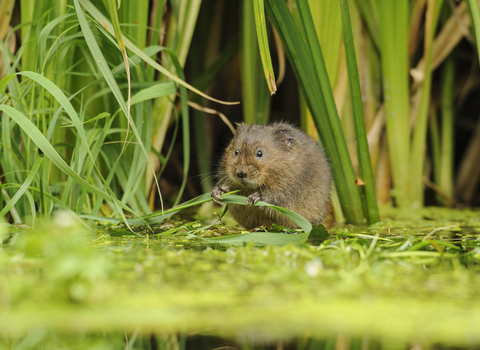Once a familiar sighting in Suffolk, the charismatic water vole has suffered the most rapid and catastrophic decline of any British mammal due to habitat loss, river pollution, and predation by the non-native American mink.
Suffolk has a great resource of potential water vole habitat with river valleys, coastal grazing marshes, ponds, ditches, lakes, fens, and reedbeds. From 2003 to 2007 every river catchment in the county was surveyed for water vole, and the results showed a dramatic decline in water vole populations since the previous county survey done in 1998. Habitat loss and predation by American mink (an invasive non-native species) were believed to be the main causes of this decline.
After this alarming discovery, Suffolk Wildlife Trust helped to slow this decline by working with landowners to improve management practices to protect and enhance water vole habitat and to ensure all protected species legislation is followed. Suffolk Wildlife Trust also set up a mink control programme throughout the county to reduce predation on water vole. This work was part of the Water for Wildlife Project, supported by Anglian Water, Essex & Suffolk Water, and the Environment Agency.
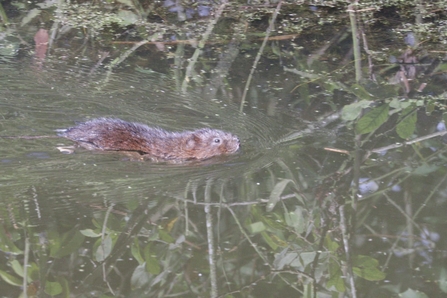
Water Vole, Trimley Marhes - Bill Mackie
The good news is that further surveys in 2007-2010 confirmed that with mink control in place, water voles have made a recovery throughout our water courses and are once again a feature of river habitat in Suffolk. Water voles are an endangered species in the UK and in Suffolk there is still more to be done to help protect water voles.
We continue to support landowners to undertake mink control on their land, provide landowners with appropriate habitat management advice, and deliver habitat restoration projects that provide the vital habitat needed for water voles and other wetland wildlife to thrive.
How you can help water voles
Volunteer
You could become a volunteer water vole surveyor with our Conservation or Ecology teams, or take part in the National Water Vole Monitoring Programme run by PTES (People's Trust for Endangered Species).
Donate
A donation to Suffolk Wildlife will support our work protecting wildlife such as water voles, restoring their habitat, and funding our work defending nature. Make a donation today, or become a member to set-up a monthly donation.
Record
If you see water vole, or spot signs of a water vole active in a river, please submit your record to SBIS (Suffolk Biodiversity Information Service).
Tread carefully
Around rivers and streams, make sure to follow the Countryside Code to avoid disturbing water voles or damaging their habitat.
Conserve water
Water voles need water. By minimising your use of water - and avoiding wasting water - you can help to keep natural habitats wet and water-vole friendly.
Suffolk Mink Control Programme
Suffolk Wildlife Trust is working with the Water Life Recovery East regional mink eradication project; a partnership project made up of different organisations in East Anglia working towards the eradication of mink from the region. Together with our partners in the project, we are supporting landowners to control mink on their land by providing smart mink raft equipment, like that shown in the photo below.
If you have seen a mink please report it here and If you think mink are causing a problem on your land and would like to join the project, please contact The Waterlife Recovery Trust.
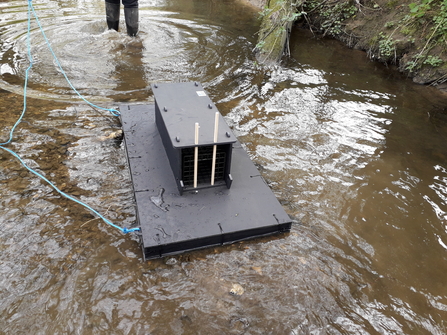
Mink raft
Water vole FAQs
Are water voles protected?
Yes; water voles are protected by the Wildlife & Countryside Act (1981), therefore it is an illegal offence to:
- Intentionally kill or injure water vole;
- Control or possess a live or dead water vole a water vole;
- Intentionally damage, disrupt, obstruct, or destroy water vole habitat or places where water vole are active.
Whilst these protections are vital, river pollution and habitat loss continue to pose huge risks to water voles in Suffolk and beyond.
How can I tell if water vole are active nearby?
Signs that water voles are active in river are:
- Burrows and bolt holes in riverbanks or by shallow water, often nearby lawns or vegetation;
- Piles of nibbled grass with a distinctive 45-degree cut;
- Distinctive footprints with splayed, star-shaped prints with the two outer toes at right angles to the three inner toes;
- Dropping or latrines (piles of droppings): small, round droppings, roughly the size of a baked bean.

Water vole footprints

Water vole droppings © Darren Tansley
What do I do if I see a water vole?
If you are lucky enough to spot a water vole in Suffolk, please submit your record(s) to SBIS (Suffolk Biodiversity Information Service): suffolkbis.org.uk/record
But remember, water voles are protected under the Wildlife and Countryside Act 1981 from killing or taking by certain prohibited methods. Their breeding and resting places are fully protected from damage, destruction or obstruction, it is also an offence to disturb them in these places.
Further reading
- Water vole, UK Species Explorer - Suffolk Wildlife Trust (https://www.suffolkwildlifetrust.org/wildlife-explorer/mammals/water-vole)
- Wilder Rivers - Suffolk Wildlife Trust (https://www.suffolkwildlifetrust.org/wilder-rivers)
- Strategy for Rivers 2024-2030 - Suffolk Wildlife Trust (https://www.suffolkwildlifetrust.org/sites/default/files/2024-10/Rivers%20Strategy%202.4.pdf)
- UK Water Vole Factsheet - The Wildlife Trusts (https://www.wildlifetrusts.org/saving-species/water-voles)
- The Waterlife Recovery Trust (https://www.waterliferecoverytrust.org.uk/)
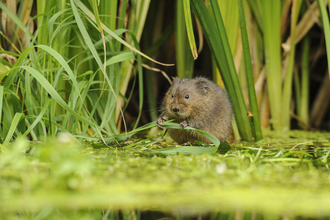
Water Vole Field Skills Training Session
Come learn how to identify and monitor water voles in their natural habitat at our hands-on field skills training session at the…

Water Vole Field Skills Training Session
Come learn how to identify and monitor water voles in their natural habitat at our hands-on field skills training session at the…
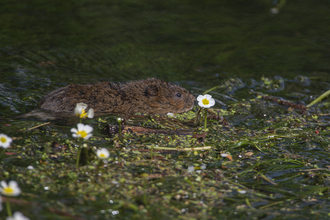
New water vole surveys hope to save endangered mammal
Water voles are considered an endangered species in the UK. These semi-aquatic mammals are one of Suffolk Wildlife Trust’s thirteen “…
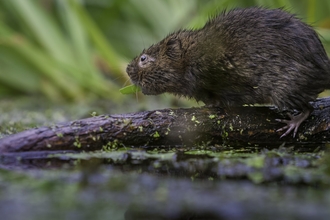
New report finds glimmer of hope for endangered water voles
A new report from The Wildlife Trusts - The National Water Vole Database Project Report - published today, identifies continued declines…

